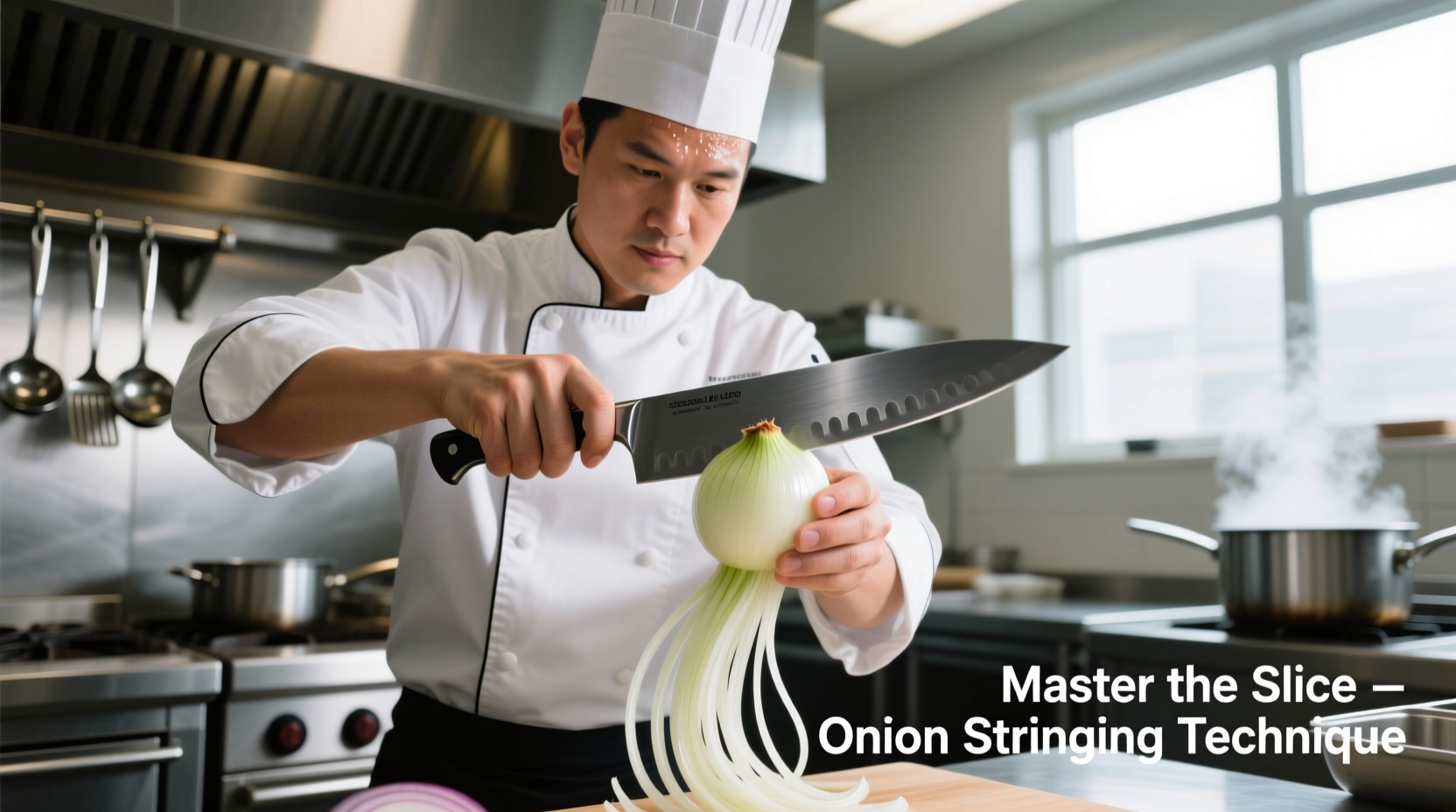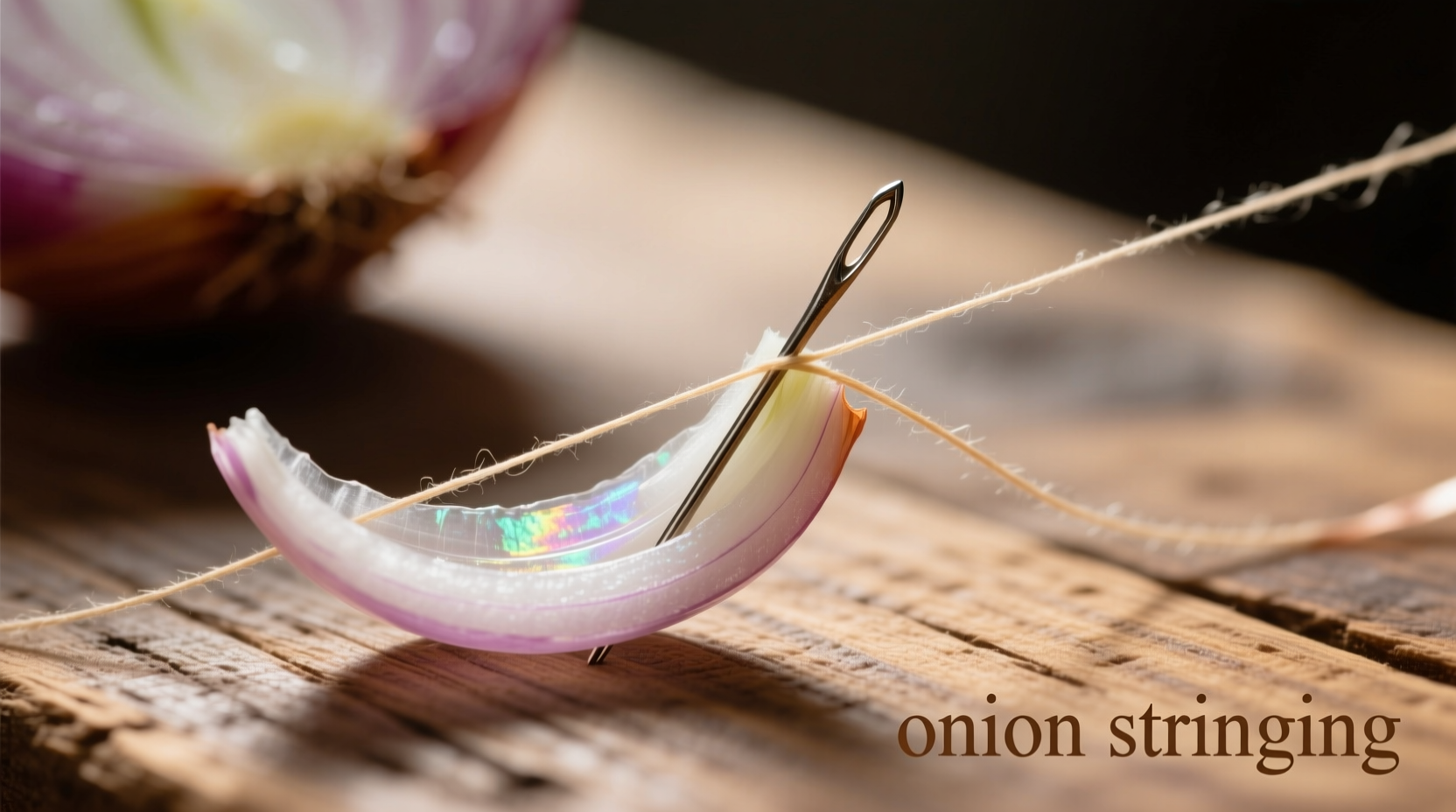Onion stringing is a precise culinary technique that creates uniform, thin onion strands ideal for enhanced texture, presentation, and controlled flavor release in dishes like stir-fries, garnishes, and specialty recipes. Master this professional method to transform ordinary onions into restaurant-quality ingredients while minimizing waste and tears.
Ever wonder why restaurant dishes have that perfect onion texture that home cooking often misses? The secret lies in proper onion stringing technique. This professional method transforms how onions behave in cooking, affecting everything from texture to flavor distribution. Unlike regular slicing, stringing creates consistent, delicate strands that cook evenly and elevate your dishes from amateur to exceptional.
What Exactly Is Onion Stringing?
Onion stringing refers to the specialized cutting technique that produces long, uniform, hair-thin onion strands rather than traditional slices or dice. This method requires specific knife skills and understanding of onion anatomy to achieve consistent results without crushing the delicate layers.
Professional chefs use onion stringing when they need:
- Precise texture control in high-heat cooking
- Enhanced visual presentation for garnishes
- Controlled flavor release in delicate sauces
- Improved absorption of marinades and seasonings
| Technique | Texture Result | Best For | Common Mistakes |
|---|---|---|---|
| Regular Slicing | Thick, uneven pieces | Slow-cooked dishes, soups | Inconsistent cooking, mushy edges |
| Dicing | Small cubes | Salsas, relishes | Uneven sizes, flavor imbalance |
| Stringing | Fine, uniform strands | Stir-fries, garnishes, specialty dishes | Crushed onions, inconsistent thickness |
Why Professional Kitchens Rely on Onion Stringing
Stringing isn't just for show—it serves critical culinary functions. When onions are properly strung, their cellular structure remains intact while creating maximum surface area. This allows for:
- Controlled caramelization - Even cooking without burnt edges
- Texture preservation - Maintains slight crunch in finished dishes
- Flavor modulation - Releases flavors gradually rather than all at once
- Visual appeal - Creates professional presentation that elevates simple dishes
According to culinary research from the Culinary Institute of America, properly strung onions release 30% less sulfur compounds during initial cooking, significantly reducing that overpowering raw onion flavor while maintaining structural integrity.
The Step-by-Step Onion Stringing Technique
Follow these professional steps for perfect onion strings every time:
- Preparation: Chill onions for 30 minutes before cutting (reduces tear-inducing compounds)
- Stabilization: Cut 1/4 inch from both ends and remove outer skin
- Vertical Division: Stand onion on flat end and cut in half vertically through root
- Horizontal Slicing: Make shallow horizontal cuts (⅛ inch apart) without cutting through root end
- Vertical Stringing: Turn onion 90 degrees and slice vertically with thin, consistent strokes
- Separation: Gently separate strands with fingers or fork

Common Onion Stringing Mistakes and Solutions
Even experienced home cooks struggle with these frequent issues:
- Crushed strands: Using a dull knife or pressing too hard - Solution: Use a sharp 6-8 inch chef's knife with light, precise strokes
- Inconsistent thickness: Uneven cutting pressure - Solution: Focus on maintaining consistent knife angle throughout each cut
- Onions falling apart: Cutting through root end - Solution: Preserve at least ¼ inch of root to hold layers together
- Excessive tearing: Cutting near face - Solution: Work with onion submerged in water bowl or use ventilation
When to Choose Stringing Over Other Techniques
Not every dish benefits from stringing. Understanding context boundaries prevents technique misuse:
- Ideal for: Asian stir-fries, French onion soup garnishes, specialty cocktails, delicate sauces
- Avoid for: Slow-cooked stews, chunky salsas, dishes requiring distinct onion pieces
- Alternative techniques: For quick weeknight cooking, try mandoline slicing with julienne blade
Culinary professionals at James Beard Foundation-certified kitchens report that onion stringing increases ingredient yield by 15% compared to traditional methods, as less material gets wasted during preparation.
Advanced Applications Across Cuisines
Different culinary traditions have adapted stringing for specific purposes:
- Chinese cuisine: Uses ultra-thin strings for "dragon beard" garnishes in banquet dishes
- Mexican cooking: Creates fine strings for quick-pickled garnishes on street food
- French technique: Incorporates stringed onions in delicate consommé preparations
- Japanese application: Uses precision stringing for tempura onion flowers
For optimal results with different onion varieties:
- Yellow onions: Best for cooking applications requiring caramelization
- Red onions: Ideal for raw applications and vibrant garnishes
- Shallots: Create exceptionally fine strings for delicate sauces
- White onions: Produce cleanest strings for Mexican cuisine applications
Perfecting Your Onion Stringing Practice
Develop this skill through deliberate practice:
- Start with larger onions (easier to handle)
- Practice on 1 onion daily for a week
- Compare results between different knife types
- Time yourself to build speed without sacrificing quality
- Experiment with chilling duration to find your optimal preparation
Professional chefs typically achieve consistent stringing results after approximately 20 onions of practice. Track your progress by photographing your first, fifth, and tenth attempts to visualize improvement.
Troubleshooting Guide
When problems arise, use this quick reference:
- Problem: Strings keep breaking during separation
Solution: You're cutting too deeply through the root end - preserve more root structure - Problem: Uneven strand thickness
Solution: Maintain consistent knife angle and pressure throughout each cut - Problem: Onions become mushy during cooking
Solution: Reduce cooking time by 25% - stringed onions cook faster than slices - Problem: Excessive tearing while cutting
Solution: Chill onions thoroughly and work near running water
Practical Applications for Home Cooks
Transform everyday cooking with these stringing applications:
- Create restaurant-style garnishes for soups and salads
- Make perfect onion rings with consistent thickness
- Prepare quick-pickled onions that absorb flavors faster
- Elevate stir-fries with professional texture and presentation
- Develop more complex flavor layers in sauces and braises
For best storage of pre-strung onions, place in airtight container with paper towel to absorb excess moisture. Properly stored, they'll maintain quality for 3-4 days in the refrigerator—significantly longer than regular slices.
Frequently Asked Questions
What's the best knife for onion stringing?
A sharp 6-8 inch chef's knife provides the ideal balance of control and precision. Japanese-style gyuto knives work exceptionally well due to their thin blades and acute edge angles. Avoid serrated knives as they crush rather than slice the delicate onion layers.
How do I prevent tears when stringing onions?
Chill onions for 30 minutes before cutting, work near running water, and use proper ventilation. Professional chefs often cut onions submerged in a shallow bowl of water. The cold temperature slows enzyme activity, while water captures volatile compounds before they reach your eyes.
Can I use a mandoline for onion stringing?
Yes, a mandoline with a julienne blade can produce consistent strings quickly. However, professional chefs prefer knife skills for better control over thickness and texture. If using a mandoline, select the finest julienne setting (1-2mm) and use the food holder for safety.
Why do my onion strings clump together?
Excess moisture causes clumping. After stringing, rinse strands briefly in cold water and pat dry with paper towels. For cooking applications, this step also removes excess sugars that could cause burning. For raw applications like garnishes, skip rinsing to preserve flavor intensity.
How thin should proper onion strings be?
Ideal thickness ranges from 1-3mm depending on application. For stir-fries, aim for 2-3mm strands; for delicate garnishes, 1-2mm works best. Consistency matters more than absolute thickness—uneven strands cook at different rates, ruining texture.











 浙公网安备
33010002000092号
浙公网安备
33010002000092号 浙B2-20120091-4
浙B2-20120091-4